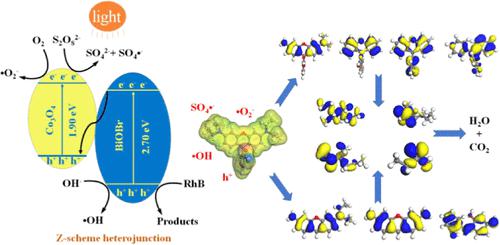当前位置:
X-MOL 学术
›
Inorg. Chem.
›
论文详情
Our official English website, www.x-mol.net, welcomes your
feedback! (Note: you will need to create a separate account there.)
Constructing a Z-Scheme Co3O4/BiOBr Heterojunction to Enhance Photocatalytic Peroxydisulfate Oxidation of High-Concentration Rhodamine B: Mechanism, Degradation Pathways, and Toxicological Evaluations
Inorganic Chemistry ( IF 4.3 ) Pub Date : 2024-02-22 , DOI: 10.1021/acs.inorgchem.4c00265
Si-Qun Zhang 1 , Huan-Yan Xu 1 , Bo Li 1 , Yan Xu 1 , Sridhar Komarneni 2
Inorganic Chemistry ( IF 4.3 ) Pub Date : 2024-02-22 , DOI: 10.1021/acs.inorgchem.4c00265
Si-Qun Zhang 1 , Huan-Yan Xu 1 , Bo Li 1 , Yan Xu 1 , Sridhar Komarneni 2
Affiliation

|
Photocatalytic coupling technologies have emerged as popular strategies to increase the treatment efficiency of dye-containing wastewater. Herein, the Z-scheme Co3O4/BiOBr heterojunction (Z-CBH) was constructed and developed as a photocatalytic peroxydisulfate (PDS) activator for the degradation of high-concentration Rhodamine B (RhB). Multiple testing techniques were employed to confirm the formation of Z-CBHs. When 0.1 g·L–1 of Z-CBH20 and 1.0 mmol·L–1 of PDS were added simultaneously under simulated sunlight irradiation, the RhB degradation efficiency could approach 91.3%. Its reaction rate constant (0.01231 min–1) was much beyond the sum of those in the Z-CBH20/light system (0.00436 min–1) and the PDS/light system (0.0062 min–1). h+, •OH, •O2–, SO4•–, and 1O2 were detected as the dominant reactive species for RhB degradation. The potential mechanism of photocatalytic PDS oxidation was proposed. The possible intermediates were determined by high-performance liquid chromatography-quadrupole time-of-flight mass spectrometry assisted with density functional theory and Fukui theory. The possible degradation pathways of RhB degradation were put forward. The toxicological properties of RhB and its intermediates were evaluated by quantitative structure–activity relationship prediction. This work will not only provide a reference for developing photocatalytic persulfate activators but also gain an insight into the degradation pathways of RhB and the toxicity of its intermediates.
中文翻译:

构建 Z 型 Co3O4/BiOBr 异质结以增强高浓度罗丹明 B 的光催化过二硫酸盐氧化:机制、降解途径和毒理学评估
光催化耦合技术已成为提高含染料废水处理效率的流行策略。在此,构建并开发了Z型Co 3 O 4 /BiOBr异质结(Z-CBH)作为光催化过二硫酸盐(PDS)活化剂,用于降解高浓度罗丹明B(RhB)。采用多种测试技术来确认 Z-CBH 的形成。在模拟太阳光照射下,同时添加0.1 g·L –1 Z-CBH20和1.0 mmol·L –1 PDS时,RhB降解效率可达91.3%。其反应速率常数(0.01231 min –1 )远远超过Z-CBH20/light系统(0.00436 min –1 )和PDS/light系统(0.0062 min –1 )的总和。 h + 、 • OH、 • O 2 – 、SO 4 •–和1 O 2被检测为RhB 降解的主要反应物种。提出了光催化PDS氧化的潜在机制。采用高效液相色谱-四极杆飞行时间质谱联用密度泛函理论和福井理论对可能的中间体进行了测定。提出了RhB降解可能的降解途径。通过定量构效关系预测评估RhB及其中间体的毒理学性质。这项工作不仅可以为开发光催化过硫酸盐活化剂提供参考,而且可以深入了解RhB的降解途径及其中间体的毒性。
更新日期:2024-02-22
中文翻译:

构建 Z 型 Co3O4/BiOBr 异质结以增强高浓度罗丹明 B 的光催化过二硫酸盐氧化:机制、降解途径和毒理学评估
光催化耦合技术已成为提高含染料废水处理效率的流行策略。在此,构建并开发了Z型Co 3 O 4 /BiOBr异质结(Z-CBH)作为光催化过二硫酸盐(PDS)活化剂,用于降解高浓度罗丹明B(RhB)。采用多种测试技术来确认 Z-CBH 的形成。在模拟太阳光照射下,同时添加0.1 g·L –1 Z-CBH20和1.0 mmol·L –1 PDS时,RhB降解效率可达91.3%。其反应速率常数(0.01231 min –1 )远远超过Z-CBH20/light系统(0.00436 min –1 )和PDS/light系统(0.0062 min –1 )的总和。 h + 、 • OH、 • O 2 – 、SO 4 •–和1 O 2被检测为RhB 降解的主要反应物种。提出了光催化PDS氧化的潜在机制。采用高效液相色谱-四极杆飞行时间质谱联用密度泛函理论和福井理论对可能的中间体进行了测定。提出了RhB降解可能的降解途径。通过定量构效关系预测评估RhB及其中间体的毒理学性质。这项工作不仅可以为开发光催化过硫酸盐活化剂提供参考,而且可以深入了解RhB的降解途径及其中间体的毒性。

































 京公网安备 11010802027423号
京公网安备 11010802027423号